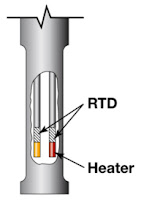Let's step through a quick example. You will see how this quick and easy to use tool saves time by navigating quickly to the website pages detailing products meeting your requirements.
The Product Finder is accessible through a number of links throughout Yokogawa's network of representatives. Clicking the link lands you on the start page of the Product Finder. For this example, I am going to search for a flow meter with the following characteristics:
- Mass flow measurement
- Non-conductive liquid
- Accuracy of 1%
- Flow measurement device must have an integral transmitter
- Tri-clamp connections
Above, I declared my location as United States. The next step, shown below, is to select "Flow" as the measurement parameter. You will see in the drop down menu that there are many measurement elements that can be selected, with Yokogawa products for each.
My selection of "Flow" from the drop down menu returns all of the company's flow measurement devices, of which there are many (this cropped screenshot, shown below, only shows four, but there were many more) . This is where the selector really helps you. Instead of examining several or many different models, the user can focus the search by adding more product characteristics. You can see the list of prompting questions on the left side of the page. Providing additional characteristics by answering the prompting questions will narrow the search results to the show only the products meeting all the criteria specified by the user.
The next image (below) shows all of my sample product attributes entered on the left column. Note that there is now only a single product that matches all of my sample criteria. The whole process took less than two minutes. By clicking on the "View More Details" button below the product image, I gain access to all of the available technical, support, and product data for my selected flow measurement device.
The process instrumentation specialists at Miller Energy are available to provide additional help in meeting your measurement challenges. Combine their product knowledge and expertise with your process know-how for the best solutions.








